French and English version. Translation : Jenny and Robin Mayer, Christopher de Chazal.
Dans les montagnes du Forez, à environ 1000 mètres d’altitude, à 4 kilomètres de Saint-Bonnet-le-Courreau, se trouve La Roffin où vivait notre plus vieil ancêtre connu à ce jour Jean Chazal, le premier du nom. C’était au début du 17ieme siècle et Louis XIII était alors Roi de France.
La Roffin is situated in the mountains of the Forez region, at 1000m altitude, four kilometres from Saint-Bonnet-le-Courreau. It is here that Jean Chazal, our oldest known ancestor and the first of that name, lived, It was the beginning of the seventeenth century when Louis XIII was King of France.
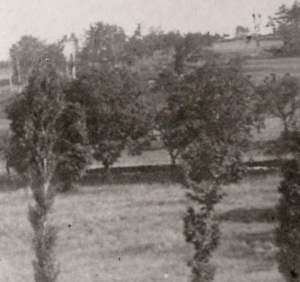
En haut à gauche on aperçoit la tour du château de la Roffin, encore debout, que possédait Jean I Chazal aux environs de l’année 1630. Photo prise vers 1920.
At top left one can see the tower of the chateau of Roffin which was owned by the first Jean Chazal in about 1630. This photo was taken in about 1920.
______________________________________________________________________________________
Texte de Roger Chazal, Docteur ès Lettres. (Roger Chazal vit à Marcilly-le-Châtel et connaît bien les lieux historiques de la famille de Chazal)
Le premier Jean est un tout petit juge, pour un titre ronflant, substitut du procureur du Roi en la châtellenie royale de Marcilly-le-Châtel. Il devait avoir des vaches, sans les garder lui-même. Mais il était, déjà, homme du Roi, bien placé sur l’axe routier ouest-est (loin des bourgs seigneuriaux) qui descend vers la plaine et le grand chemin du Roi, et peut-être mieux placé en stratégie d’ambitions qu’un notaire royal.
Le site de la Roffin mérite en lui-même attention. C’est peut-être le fond de l’affaire, que les “Chazal” y aient commencé ou non leur carrière de “chasés”. (Le chasé s’oppose au domestique qui vit chez son seigneur. Un vassal chasé est celui qui recoit un bénéfice ou un fief. Un serf chasé est celui qui n’est pas nourri et logé dans la maison du maître” selon le dictionnaire Favier de la France médiévale).
Aux rebords hauts de la vallée, le ciel s’ouvre, et l’on se trouve, côté sud, sur un long faux replat où coule le petit ris de Cruzolle. Au sud, la pente continue à monter, plus douce, et c’est là qu’est La Roffin, et qu’était en 1624 “Jean Chazal” dans son “château”. Pas une grosse affaire certainement -le bâtiment a complètement disparu-, ce n’est plus qu’un lieu géométrique au milieu des près en pente, sur un petit ressaut rocheux où s’accroche un bouquet d’arbres, à peu près équidistant des trois exploitations agricoles séparées qui constituent La Roffin d’aujourd’hui (et dont les bâtiments ont peut-être autrefois fait large usage de ses pierres). Près de la ferme la plus proche de la route principale est le mur massif de l’enclos, devenu jardin, où était, dit-on la chapelle.
Le meilleur point de vue sur les lieux est depuis la petite route du dessus, qui relie Aubigneux à Soleymieux. Axe de passage entre plaine et haute montagne, où la route principale, en dessous, file d’est en ouest, mais on est loin de tout chef-lieu. Saint-Bonnet est loin derrière, et Saint-Georges semble près devant (1,5 km à vol d’oiseau), mais l’entaille profonde s’interpose.
Roger Chazal tells us:
(Roger Chazal lives in Marcilly-le-Chatel and is well placed to know the de Chazal family history; a Doctor of Literature has done a great deal to inform us of the area and facilitate our travel)
The first Jean was a very minor judge, to give him a more grand title, Assistant tax collector to the King in the landed tenancy of Marcilly-le-Châtel. He must have had some cows, cared for by a cowherd in his employ. He was already a “King’s Man”, well placed on the west-east route (well away from the market towns of the ruling classes) whichdescends towards the open country and the great King’s Road; and perhaps better strategically placed in terms of ambition than a royal notary. The site of La Roffin itself is deserving of some comment. It is perhaps the heart of the matter where the Chazals did or did not begin their social climb. (The word “chasé” is used and the Favier dictionary of medieval France states: A chasé is the opposite of a live-in servant. A vassal-chasé is one who receives a benefice or tied accommodation. A serf-chasé is one who is neither housednor fed at the masters’ expense. This explanation is unsatisfactory and your translator has chosen the word “climb” to denote climbing out of servitude).
On the height above the valley the skies open, and on the south side one finds oneself on a long false ridge where runs the small stream of Cruzolle. To the south the slope continues to rise less steeply, it is there that La Roffin stands, and it was there in 1624 that Jean Chazal lived in his ‘castle’. Certainly it was nothing special and the building has since completely disappeared-, it is now only a geometric point in the middle of sloping fields, on a little rocky promontory where a stand of trees hang, about equidistant from three individual farms that make up La Roffin of today (and whose buildings hitherto perhaps made good use of its masonary).
Close to the farm which is the nearest to the main road is the massive wall of the paddock, now a garden, where it is said the chapel was situated.
The best view of the area is obtained from the small road above, which joins Aubigneux to Soleymieux. This is the main axis from open country to mountain, where the principal route below goes from east to west, far from any populous centre. Saint-Bonnet is far behind and Saint-Georges seems close in front (1,5 km as the crow flies), but this is just an illusion because there is a deep ravine in the way
____________________________________________________________
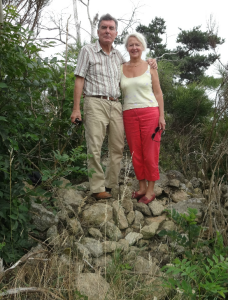
Anny et Jean-Pierre de Chazal sur les vestiges de ce qui fut le “château”. Les pierres ont en majorité servi à la construction des fermes environnantes. Photo prise en 2013 par Roger Chazal.

At the remains of the chateau of Roffin. The majority of the masonry was used for the construction of the adjoining farms
Vue aérienne de la ferme de Jeanne Arnaud et de son frère, située en contrebas du château de Jean Chazal I. L’enclos sur le devant, devenu un jardin potager, de ce qui fut le cimetière de la Roffin. Il existait à l’entrée du cimetière une petite chapelle ainsi qu’une imposante croix en pierre qui portait à sa base une date : 1650. Roger Chazal nous précise que “la construction d’une chapelle éloignée était souvent l’oeuvre du notable du lieu”.
“Ariel view of Jeanne Arnaud and her brother’s farm, lying below Jean 1 Chazal’s chateau The enclosure in the foreground, now a kitchen garden was, at one time, the Roffin cemetery. At the entrance to the cemetery were a small chapel and an imposing cross of stone which had at its base an inscription: “Jean Chazal 1650″
L’entrée de la ferme. Photo prise en 2013.
The entrance to the farm
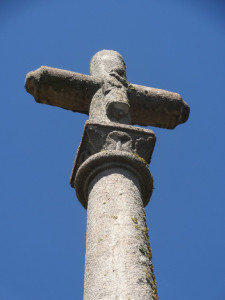
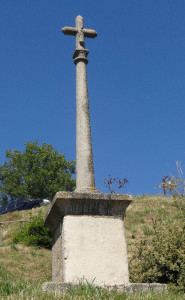
Croix qui se trouvait devant la chapelle et le cimetière de la Roffin et qui a été déplacée à l’entrée du village de Saint-Bonnet-le-Courreau. Photos prises en 2013
The cross which has been moved from its original position. Also photographs taken from Tristan’s “Genealogy” which can be found on the website (page 10 of 003 History doc), together with a view of the valley from the lower road.
Photos de Tristan de Chazal extraites de son dictionnaire de la famille de Chazal.
_______________________________________________________
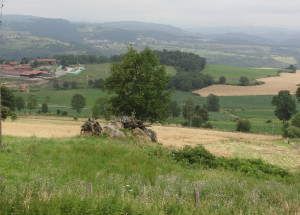 Point de vue sur la vallée depuis la petite route du dessus.
Point de vue sur la vallée depuis la petite route du dessus.
View of the valley from the higher road.

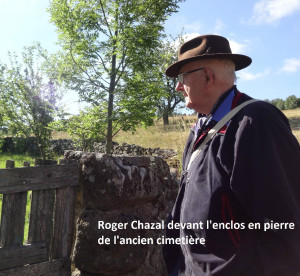
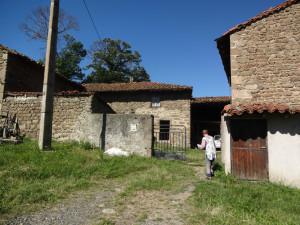
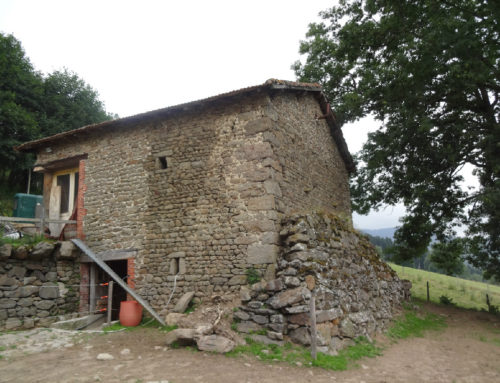
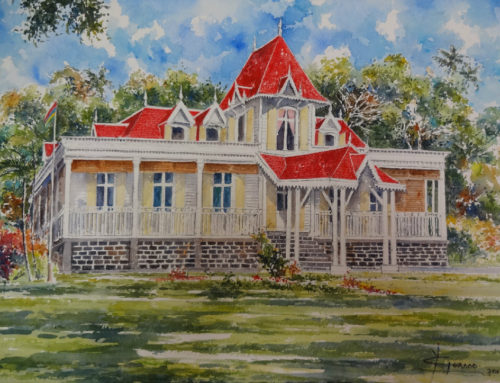
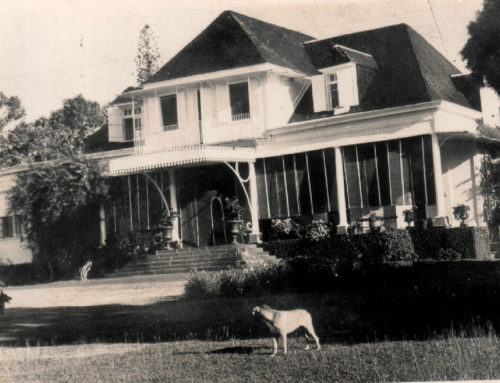

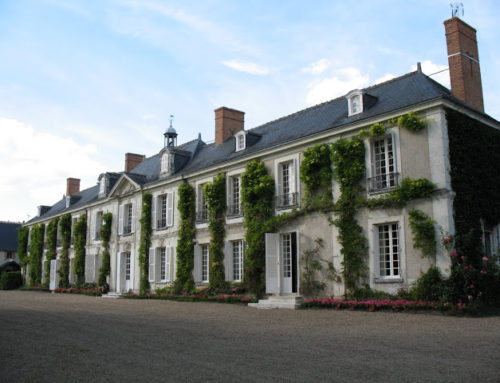
Leave A Comment
You must be logged in to post a comment.